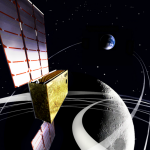
Global Space News: Comet Interceptor mission “adopted”
On June 8, the European Space Agency (ESA) announced that the study phase for the Comet Interceptor mission was complete, and the mission had been formally approved for construction for a scheduled launch in 2029. Comet Interceptor is an ESA-led mission with JAXA participation, and the news was eagerly received by the Comet Interceptor team at ISAS.
The Comet Interceptor mission has been formally adopted by ESA! JAXA plans to provide a CubeSat-based flyby probe for this mission, and as a member of the Comet Interceptor Japanese working team, I am very happy that the mission has been formally adopted by ESA.
Ozaki Naoya, Department of Spacecraft Engineering
The Comet Interceptor mission comprises of a main spacecraft and two CubeSat probes, one of which will be designed and built by JAXA. This unusual modular design is tailored to chase a rare class of celestial object that has never previously been seen up close: a long period comet.
Long period comets originate in the distant Oort Cloud that sits on the very edge of our Sun’s gravitational reach. Most comets that we see have periods of less than 200 years and originate from the Kuiper Belt, where Pluto resides. But while the Kuiper Belt starts at 30 times the distance between the Sun and the Earth, the Oort Cloud is between 2,000 and 100,000 times that distance.
For such distant visitors, we get just a single chance at a close-up look before they leave our vicinity for potentially hundreds of thousands of years. The purpose of Comet Interceptor’s three module design is to maximise the information gathered during the brief encounter by acquiring three different views on the comet nucleus and coma.

However, long period comets are not easy to catch. The Oort Cloud is too far away to observe directly, and incoming comets are not discovered with enough time to launch a mission. Comet Interceptor therefore has an original mission design, as Assistant Professor Ozaki Naoya explains.
Comet Interceptor is designed as a “rapid-response flyby mission” that will be stationed at a Lagrangian point of the Sun-Earth system and will immediately fly by a long period comet once it is discovered. Such long period comets are scientifically very interesting objects because they receive almost no heat from the Sun and maintain the “primordial state of the Solar System” with lots of water ice and organic matter.
By lying in wait at a stable location (Lagrangian point) close to the Earth, Comet Intercepter hopes to catch up with a long period comet on its first trip into the inner Solar System. As the Oort Cloud is so far from the Sun, a comet on its first inward journey would have been in incredibly cold conditions throughout its entire lifetime. This chilled existence would preserve its original composition of rock and ices that was assembled at the same time as the Sun and planets. Comparison between a rare long period comet and other small bodies can therefore tell us about how material changed and travelled through the Solar System, eventually forming planets like the Earth.
An intriguing alternative target for Comet Interceptor would be an interstellar small body, such as ‘Oumuamua. Similar to long period comets, these small bodies from outside our Solar System move too swiftly to launch a new mission after their discovery. With Comet Interceptor in place, the team can be ready for the most scientifically exciting target.

However, the need for small standby missions that can react quickly to new discoveries is not limited to the scientific exploration of far away visitors. Such a mission concept may also allow us to investigate celestial objects that pose a danger to the Earth. Ozaki notes that this makes the development of such missions important for the future at JAXA and overseas.
In addition to its scientific value, JAXA is now planning to launch many challenging missions using micro/nano spacecraft, starting with the development of the Comet Interceptor. In fact, the need for a rapid response mission like Comet Interceptor is also attracting attention in the field of “Planetary Defence” to protect the Earth from the threat of asteroid impact, and countries around the world are considering “where and how to stand by”. JAXA is also planning to develop a rapid response flyby mission as one of the future small body exploration programs.
Comet Interceptor is the latest in a series of collaborative missions between ESA and JAXA. On that list is the Mercury Mission BepiColombo, which launched in 2018. While larger in size than Comet Interceptor, BepiColombo is also a composite spacecraft consisting of two Mercury orbiters designed by each space agency. The ESA orbiter will examine the surface and internal structure of Mercury, while the JAXA orbiter will investigate the interaction between the planet’s magnetic field and solar wind that streams from the close-by Sun.
Professor Ogawa Hiroyuki recalls the transport of the JAXA orbiter “Mio” to the launch site in French Guiana onboard the large Russian transport aircraft.
BepiColombo is the first international joint mission to Mercury between ESA and JAXA. “Mio” the JAXA module that will be transported to Mercury by ESA’s spacecraft and separated on a Mercury orbit. This is the same composition that will be used for Comet Interceptor.
On May 2018, Mio was transported from ESA’s laboratory, ESTEC, in the Netherlands to the Ariane 5 launch site, CSG, in French Guiana, South America. ESA chartered an Antonov An-225, the world’s largest Russian transport aircraft, to carry the BepiColombo spacecraft including “Mio.”
I accompanied this transport.
The ESA people I went with had told me before boarding that “the toilets will be so dirty that you will not want to use them”, “the food will be very bad”, “the chairs will be almost broken”, “it’s very noisy and uncomfortable.” So I was filled with anxiety before I boarded the Antonov.
In fact, I found that this was not the case. The toilets were clean, there were chairs to sit on, and the crew’s special minestrone soup was delicious. The ride was actually very comfortable. The only disappointments were that there were no windows so we couldn’t see what was going on outside, and we couldn’t drink alcoholic beverages.
However, the ESA person I went with neither went to the toilet nor ate any food!
Ogawa Hiroyuki, BepiColombo Mio Project Manager
With a strong history of small body missions such as the two Hayabusa spacecraft, and upcoming DESTINY+ and MMX missions, the Comet Interceptor mission was a natural fit for JAXA ISAS expertise. ISAS Deputy Director General Fujimoto Masaki comments on how the collaboration between the two space agencies drives new ideas for the future.
My favourable impression of ESA was created by the agency’s firm execution of the long-term, large-scale Rosetta Mission, which succeeded in exploring Comet 67P/C-G. When ESA started to be interested in building their F (Fast)-class category, they contacted ISAS for consultation and we were invited to attend relevant workshops. As a result, when I read the Comet Interceptor proposal, I couldn’t help thinking “This is a mission that should be performed by ISAS!”. We therefore made preparations for Japan to contribute to the project. We have been inspired to systematically design a way of utilising small spacecraft for small body explorations. So many small bodies, so many things to explore, so it’s simply natural to have our small body exploration program leveraged by small spacecraft, isn’t it Ozaki-san?
Fujimoto Masaki, Deputy Director General
When Comet Interceptor utilises its multi-modular small spacecraft design to chase down a long period comet, what might we expect to find? Professor Usui Tomohiro who is leading the analysis of the asteroid sample returned by Hayabusa2 says that the laboratory findings indicate that our views of these different classes of asteroid and comet may need to change.
The analysis of the Ryugu sample returned by Hayabusa2 shows a variety of hydrous and organic materials in the sample, implying an affinity to a type of comet and their genetical relationship. We may need new definitions of asteroid and comet! Comet sample return will provide clue to the answer of this question. I’m an avid supporter of Comet Interceptor as an astromaterial curator because this mission will pave the road for the new era of comet sample return.
Usui Tomohiro, Astromaterials Science Research Group Manager
As we start to explore more of our Solar System, will we find a picture that explains the variety of worlds, from massive to tiny, that orbit the stars?
“Global space news” is a chance for us to highlight important developments across the world and share our excitement of these achievements.
Further information:
Comet Interceptor website (external site)




 Previous Post
Previous Post Next Post
Next Post






